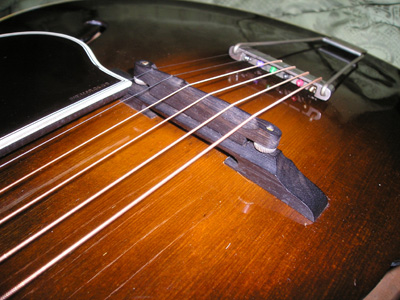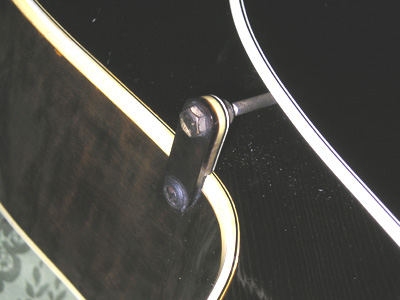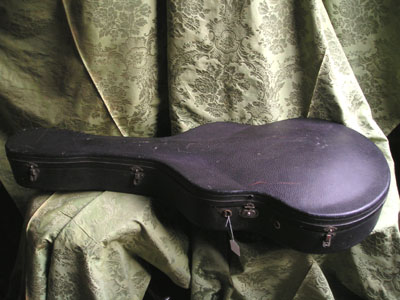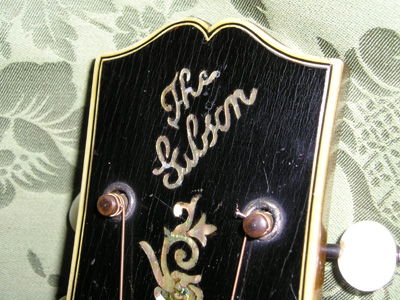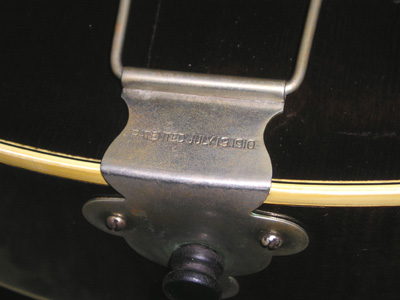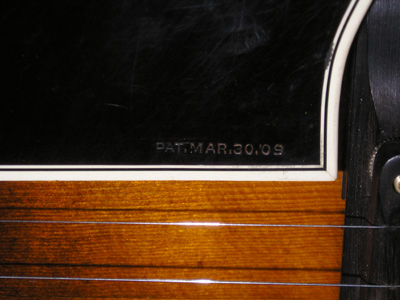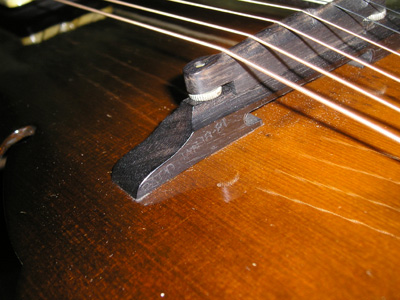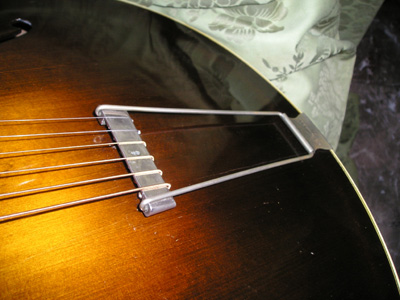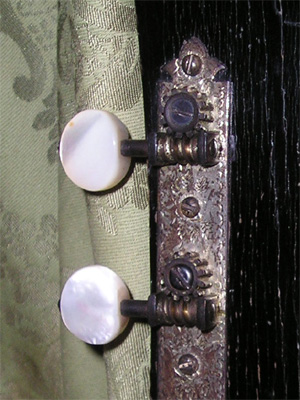
GIBSON L-5 Lloyd
Loar, 1924
signed by Lloyd A. Loar on
December 1st, 1924
serial number 77404
Le prime ventiquattro L-5 firmate da Lloyd A. Loar tra il 1923 e il 1924, insieme alle flat top Martin, costituiscono il punto di partenza della storia della chitarra moderna. La L-5 e' il primo modello realizzato con le caratteristiche che ancora oggi contraddistinguono le migliori chitarre da jazz: corpo in massello intagliato e intonato a mano, tastiera sollevata rispetto alla tavola armonica, buche ad f. La straordinaria grazia, la cura del dettaglio, il design austero ma innovativo, facevano di questo strumento un oggetto prestigioso che si distaccava nettamente da qualsiasi altra chitarra prodotta fino ad allora.
La chitarra che qui vedete fa parte del gruppo di strumenti realizzati nell'ultimo mese di permanenza alla Gibson di Loar, uno dei grandi geni della liuteria americana. Delle altre 23 chitarre di cui si ha oggi notizia, solo una e' stata realizzata nel '23 anche se ufficialmente e' indicato il 1922 come anno di inizio produzione (ma nessuna -5 del '22 e' mai stata rintracciata), mentre tutte le altre sono costruite nel 1924. Questo esemplare e' in condizioni praticamente inalterate, con tutte le parti originali. Come la maggior parte delle prime L-5 ha il top in abete, le fasce e il manico in acero e il fondo in betulla (birch). La tastiera e' in ebano con semplici dot in madreperla. Sulla paletta, sotto al logo "The Gibson", campeggia il caratteristico intarsio che ancora oggi adorna le L-5. L'hardware e' argentato, i bottoni delle meccancihe sono in vera madreperla, il ponte e' in ebano, e sia ponte che battipenna che attaccacorde recano dei numeri di brevetto. Insieme all'adozione del truss rod regolabile, tutti questi elementi fanno della L-5 il meglio di quanto una chitarra potesse offrire al musicista.
All'interno del corpo, sotto la tavola armonica, e' sospesa una tavola secondaria con due F stilizzate (piu' simili a due C in realta'), il cosiddetto Virzi Tone Producer, che Loar aveva commissionato ai liutai Palermitani F.lli Virzi, ed installato sia sulle chitarre che su altri strumenti della serie 5, tra cui i celeberrimi mandolini F-5 adottati da maestri del bluegrass come Bill Monroe. Molti musicisti hanno rimosso il Virzi Tone dai propri strumenti, ma questa chitarra anche da questo punto di vista non e' stata alterata.
L'estrema rarita' di queste chitarre le rende praticamente sconosciute al grande pubblico, dato che sono davvero poche le persone che possono dire di averne suonata una. Il loro fascino poggia anche su questo alone di leggenda che le circonda. Tuttavia, prescindendo da questo aspetto, la cosa che piu' colpisce in questa L-5 e' il suono. Detto semplicemente, e' la chitarra acustica piu' bella che ho mai sentito. La ricchezza, il volume, il calore, il sustain, un misterioso riverbero forse dato dal Virzi, la rende non paragonabile a nient'altro. Superato l'impatto con l'enorme manico a V, la sensazione e' difficilmente descrivibile.
Tutte le 24 Loar L-5 e i mandolini F-5 sono raccolti qui: www.mandolinarchive.com

The first twenty-four L-5s signed by Lloyd A. Loar between 1923 and 1924, together with early Martin flat-tops, mark the date of birth of the modern guitar. The L-5 is the first model with all the features that are still found today on the best jazz archtops: hand-carved and graduated solid-wood body, fingerboard raised above the soundboard level, f-shaped sound holes. The extremely graceful shape, the attention to detail, the austere but innovative design made of this guitar a radical departure from anything else produced until then.
The guitar you see here belongs to the last month of Loar's employment at Gibson. Loar can rightfully be considered - if not a genius - as one of the fathers of american lutherie. Of the other 23 Loar-signed L-5s only, 22 are from 1924 and only one is dated '23, even if 1922 is commonly indicated as the official introduction year. But no '22 L-5 has ever surfaced. This guitar is in pristine, unaltered condition, with normal checking and light playing wear. As almost all the early L-5s it has a two-piece carved birch back, solid spruce top, maple sides and neck. The beautiful ebony fingerboard has very plain pearl dot inlays. Under the headstock "The Gibson" logo there is the trademark flower-pot L-5 inlay. All the hardware is silver-plated, with real mother-of-pearl tuner buttons, ebony bridge, tortoise plastic pickguard with bound bracket. Bridge base, tailpiece and pickguard all bear patent numbers. All these elements, with the new adjustable truss rod made of the L-5 the very best a guitar could offer to the musician.
Inside of the body, suspended to the top, there is an oval secondary soundboard with two f (actually C-shaped) holes, the so-called Virzi Tone Producer, built by sicilian luthiers Virzi brothers, installed by Loar on many 5-series instruments, including the revered F-5 mandolins later used by bluegrass heroes like Bill Monroe. Many musicians removed the Virzi Tones from their instruments, but this guitar is unaltered also in this respect, and today this Virzi is back in Sicily!
The extreme rarity of these guitars makes them almost unkown to the mass of guitar fans, since the ones who have actually played one are so few. Rarity and mystery add a special touch to their legendary status. Besideds that, anyway, what is really stunning is the sound. Simply put, this L-5 is the best-sounding acoustic guitar I have ever owned and played. Richness, volume, warmth, incredible sustain and harmonics, plus a mysterious reverb maybe due to the Virzi, put it in a class by itslef. Once you overcome the impact with the oversized V-neck, it is an indescribable sensation.
All the known Loar guitars and mandolins are listed in this website: www.mandolinarchive.com
